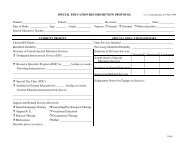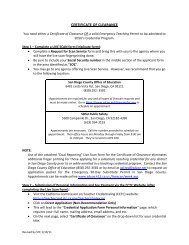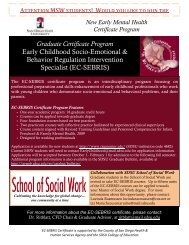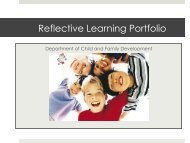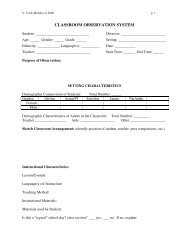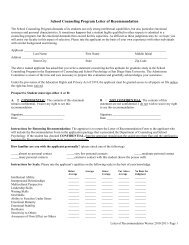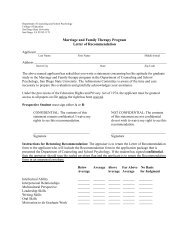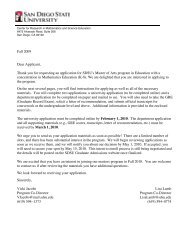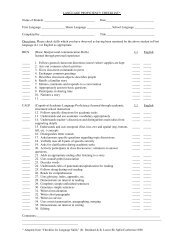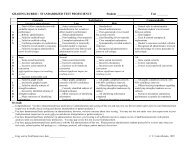Highlights of the Woodcock Johnson III- Diagnostic Supplement ...
Highlights of the Woodcock Johnson III- Diagnostic Supplement ...
Highlights of the Woodcock Johnson III- Diagnostic Supplement ...
Create successful ePaper yourself
Turn your PDF publications into a flip-book with our unique Google optimized e-Paper software.
In Test 3: Spatial Relations, all subjects begin with an introduction and sample items thatinclude a standardized procedure to ensure <strong>the</strong> subject understands <strong>the</strong> directions. Additionally,a pointing response may be used if <strong>the</strong> subject does not know <strong>the</strong> letter names. Test 3: SpatialRelations is a measure <strong>of</strong> visual-spatial thinking (Gv).Test 21: Memory for Names measures long-term retrieval (Glr) in a controlled-learning formatthat assures all subjects are given identical opportunities to learn <strong>the</strong> task. Prior learning doesnot affect test performance. Additionally, <strong>the</strong> test utilizes a pointing response from <strong>the</strong> subject so<strong>the</strong>re are no expressive language requirements. Incorrect responses are identified immediately.That is, <strong>the</strong> examiner acknowledges <strong>the</strong> incorrect response and <strong>the</strong>n points to <strong>the</strong> correctresponse; this procedure helps clarify understanding <strong>of</strong> <strong>the</strong> task requirement.Test 23: Sound Patterns–Voice is a measure <strong>of</strong> auditory processing (Ga). The test isappropriate for assessing <strong>the</strong> sound discrimination abilities <strong>of</strong> bilingual individuals because <strong>the</strong>reare no meaningful language components in <strong>the</strong> test stimuli. For this test, <strong>the</strong> subject needs onlyto understand <strong>the</strong> concepts <strong>of</strong> “same” and “different.”Test 5: Concept Formation is a test <strong>of</strong> fluid reasoning (Gf). Although this test requires somebasic English-language vocabulary knowledge (such as <strong>the</strong> words different, drawing, and rule),ei<strong>the</strong>r beforehand or gained through <strong>the</strong> teaching/modeling characteristic <strong>of</strong> <strong>the</strong> test directions,bilingual subjects with English oral-language abilities at <strong>the</strong> age 4-0 level or higher typically have<strong>the</strong> English-language vocabulary required for this test. Through standardized introduction andsample items that utilize corrective feedback, all subjects are given <strong>the</strong> opportunity to learn <strong>the</strong>task demands.These four thinking ability tests also comprise <strong>the</strong> Thinking Ability–Low Verbal cluster. Thiscluster provides a language-reduced composite <strong>of</strong> a subject’s intentional cognitive processingcapabilities.Cognitive Efficiency. Two tests comprise <strong>the</strong> Cognitive Efficiency–Standard cluster, whichmeasures <strong>the</strong> subject’s rate and span <strong>of</strong> automatic cognitive processing. Test 6: VisualMatching is a measure <strong>of</strong> processing speed (Gs) and Test 7: Numbers Reversed is a measure<strong>of</strong> short-term memory (Gsm). Both <strong>of</strong> <strong>the</strong>se tests have low receptive language requirements.Two versions <strong>of</strong> Test 6: Visual Matching are available. Test 6: Visual Matching 1 requires <strong>the</strong>subject to point to two matching shapes in a row <strong>of</strong> four to five shapes. Test 6: Visual Matching2 requires <strong>the</strong> subject to locate and circle <strong>the</strong> two identical numbers in a row <strong>of</strong> six numbers.There are no expressive language requirements for Test 6: Visual Matching.Test 7: Numbers Reversed requires some basic English-language vocabulary knowledge (suchas <strong>the</strong> words numbers and backward and <strong>the</strong> numeral names “one” through “nine”). However,bilingual subjects with English oral language abilities at <strong>the</strong> age 5-0 level or higher typically have<strong>the</strong> English-language vocabulary required for this test.Examiners who administer <strong>the</strong> tests included in <strong>the</strong> GIA-Bil scale can obtain additionaldiagnostic information from <strong>the</strong> intra-cognitive–standard discrepancy procedure. When ei<strong>the</strong>rTest 31: Bilingual Verbal Comprehension–English/Spanish or <strong>the</strong> BVAT has been administered,<strong>the</strong> verbal ability includes responses to items administered in <strong>the</strong> subject’s first language. Also,<strong>the</strong> Thinking Ability–Low Verbal score is evaluated against <strong>the</strong> same “O<strong>the</strong>r” score as ThinkingAbility–Standard.





